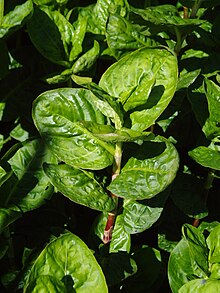User:Jhen202/Persicaria tinctoria
| Persicaria tinctoria | |
|---|---|

| |
| A photo of the Persicaria tinctoria leaves | |
| Scientific classification | |
| Kingdom: | Plantae
|
| Class: | Equisetopsida
|
| Order: | Caryophyllales
|
| Family: | Polygonaceae
|
| Genus: | Persicaria
|
| Species: | tinctoria
|
Persicaria tinctoria is an annual herbaceous plant that is apart of the buckwheat family. Its common names include Japanese indigo and Dyer's Knotweed. It is native to Vietnam and Southern China and it is synonymous with Polygonum tinctorium.[1] It has been cultivated for both food and medicinal properties, most notably for indigo dye.
Description
Persicaria tinctoria is an annual herbaceous plant that has an erect stem and is usually branched. Its growth can range from 50 to 80 centimeters, but it is around an average of 0.75 meters. It is a noded plant so when being planted it will root from the nodes on the stem.[2] Its flowers are small and come in diverse colors of white and pink and its roots are shallow. [3] Its leaves are large narrow and pointed and its stem is elongated. Persicaria tinctoria is a photoautotrophic plant so it is able to utilize its light energy and inorganic carbon to transform light into chemical energy. This chemical energy is used to produce the pigmentation for the indigo dye. [4]
Distribution and habitat
Persicaria tinctoria is native to South Central China and the Vietnam area. It has been introduced and distributed across several countries including North-Central China, Korea, Tibet, Ukraine, and North Caucasus. In the 13th century, its growth widen towards central European countries including England, France, Germany, and Italy.[5] Most notably, it was popular in East Asia during the Western Zhou period until 771 B.C. until Indigofera became the dominant plant. It was classified by Aiton H.Gross in 1919.[6]
Persicaria tinctoria germination requires soil that is moist and above 50 degrees Fahrenheit. [2] It's considered frost-sensitive so it does not do well in cold dark temperatures and needs full sunlight and well-drained neutral soils. However, to bloom flowers, there is a requirement for short daylight hours, about 14 hours or less. [7]The habit of the herb is places that are mainly weed-infested such as moist valleys and near streambanks mainly between 200 and 1000 meters. [8]
Persicaria tinctoria have insects as their main pollinators and are immune to rabbits as predators as the plant contain oxalic acid which is notorious for causing photosensitivity. [9]
Taxonomy
Persicaria tinctoria is apart of the Plantae kingdom and the class Equisetopsida which is horsetail. Its order is Caryophyllales, which is commonly referred to as the pink or carnation family and its suborder is Caryophyllanae. It's apart of the Polygonaceae or the Buckwheat family under the genus of Persicaria and the species of tinctoria. It is also synonymous with Polygonum tinctorium, Polygonum tinctorium, Ampelygonum tinctorium, and Pogalis tinctoria. It was classifed by Aiton H.Gross. [10]
Uses
Persicaria tinctoria are mainly sourced for their stem and leaves as they contain several properties that are good for food and medicine. The plant is anti-inflammatory and when it is young it can be cooked. The seeds can be eaten either raw or cooked. Through hydrolysis and acidification, the leaves can produce about 4-5% of indigo pigment to produce a blue dye. Indigo blue dye was used for staining clothing, particularly blue denim jeans. It is also used in pediatric dermatological treatment such as freckles, pimples, mumps, etc. The leaves and stem have anti-inflammatory, antipyretic, and depurative properties which can be used to decrease the permeability of capillaries in the blood. It also increases the phagocytosis of white blood cells. The leaves and fruit were used to treat seafood poisoning. [8]
Text is available under the CC BY-SA 4.0 license; additional terms may apply.
Images, videos and audio are available under their respective licenses.
